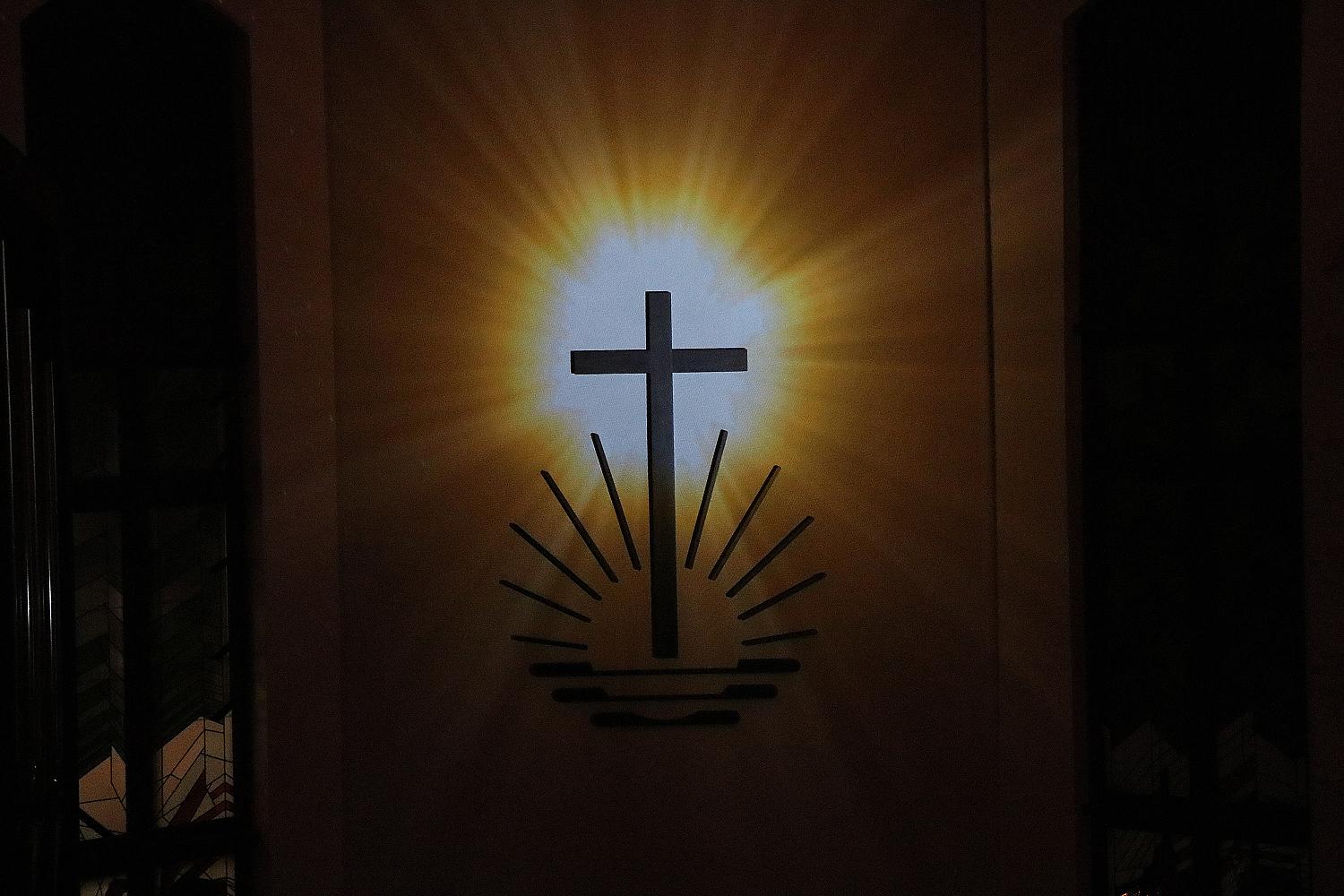
First there was light, and everything was good in the world. Then came evil, which divides. Then came evil, which divides. God’s love, however, builds bridges and brings people together. This was recently experienced in an unusual way in a German church with light and sound.
“In the beginning there was light.” The voice-over invokes a warm, pulsating light in the New Apostolic church in Karlsruhe-Central. The people sitting on the balcony don’t know where to look first: up to the domed roof, where thousands of stars twinkle, or at the stained glass windows, from which light streams into the church even though it is dark outside, or to the emblem above the altar, behind which the sun seems to be rising.

God, the origin of all things
“God’s warming love bathes the earth in dazzling light, sets seas and rivers in motion, makes forests and meadows blossom, and creates life, diversity, and beauty—all conceived as a collective without limits in eternal harmony,” the voice says. “God is the origin of everything,” Verena Potthoff explains later. The fashion designer and cultural scientist at the University of Applied Sciences in Karlsruhe—and choir member and floral designer in the Karlsruhe-Central congregation—helped create the light and sound installation for the 125th anniversary of her congregation at the beginning of October. “We have already done something like this as an interdisciplinary project with students, and I thought when planning our celebration: let’s add another item to the programme.”
Once the voice has fallen silent, organ music sounds from the loudspeakers. Soon it is mixed with electronic music. Conductor and organist Bernd-Jürgen Kulick and his son Yann composed the music, which corresponds exactly to what people see in the church. It becomes brighter and brighter in the church and the circular light moves higher on the cross, representing God’s goodness, love, and power.
All the elements in the church are included. Then the audience hear each of the organ pipes. Thomas Beisiegel, who studied virtual design, is not a New Apostolic, but promised Verena and her husband Werner Glas that he would help them with the production, as they would not get very far technically.
Together, Verena, Werner, and Thomas created a 3D model of the nave. All the details were then defined in Thomas’s programme and he was able to plan the effects in the 3D space. He used Verena’s text as a basis. They served as his “stage directions”. The three or four of them talked again and again. Thomas’s girlfriend, Jaqueline Kurzbach, also pitched in. The music gave the whole installation structure. The effects and colours were edited. Verena and the others spent night after night in the church.
They wanted it to be an overall aesthetic experience. “We didn’t want people to just see and hear it and process it rationally, but to actually feel it all. Even if you don’t know anything about it, you can still sense what it all means.”

Evil comes into the world
In the second part, eerie music and harsh bright light make it clear that evil is coming into the world. “With the arrival of evil, the energy changes,” the AI voice says which Verena has edited for this purpose. “It divides, destroys, provokes conflict and strife, turns people against God and against each other, fills hearts, and covers the earth with suffering and sadness.” All the contours of the room seem to dissolve and shadows move sinisterly along the walls, crawling like a snake.
Verena was worried about how this part would be received by the audience. She had the full backing of the rector of the congregation and his complete trust; he did not even want to see the production beforehand. “I was very impressed by the commitment of our brothers and sisters,” Tobias Metz, the rector, says. “It was fascinating to see how sound and image created emotion and how the significance of Jesus and His sacrifice was conveyed through our emblem in a way I have never seen before.”
Soon, however, there is a change: the colours become more pastel and the cross above the altar takes on a clear structure. “In the beginning, everything here is evil, nothing endures,” Verena explains, “but through the power of God, something good comes into being. Some things develop for the better and then there is a struggle”—represented by different forms that constantly clash.
Verena, too, had an inner struggle. “Telling everyone I go to church on Sundays is not really my strong point,” she says. But shortly before the congregation’s anniversary celebration, she talked about it and her faith in a newspaper article. “In one go, I didn’t have to say anything.” Several of her friends, who previously knew nothing about Verena’s commitment, came to the performance.
Good triumphs over evil
The third part begins with peaceful music and warm light: “A gentle warm ray reveals that God’s love has not passed away. It is, was, and will always be there. It penetrates the darkness and builds bridges. It heals wounds and gives hope. The love of God and His proximity draws us to that which is good, unites people around the world, and brings peace worldwide.” Warm rays of sunshine combined with peaceful music give the audience a good feeling. Suddenly, light seems to flow through the through the walls of the church. “This symbolises God’s love. Evil makes people hard-hearted and unyielding, and it builds walls. God’s love breaks down these walls. God unites, creates connections, builds bridges, and breaks down petrified walls,” Verena explains.

The light and sound installation was also intended to be a bridge for the citizens of Karlsruhe. “We wanted people to come simply because something fascinating was being shown here. We wanted them to come in, take a look, and experience us and realise: those who always go to church in a black suit are not all that strange. In fact, they are really nice,” Verena says.




